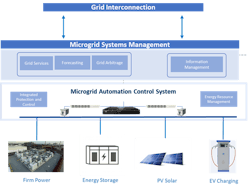Distributed Generation and Microgrids for High Density EV Charging Networks
The Department of Energy (DOE) predicts a 38% increase in electricity consumption by 2050, mostly due to the high penetration of electric vehicles. The market and utilities will need solutions to reduce the impact of EVs on distribution networks, ensure the reliability of their local distributions systems and satisfy the market needs of fleet vehicle owners and operators. The impact of EVs on legacy electric supply and distribution systems will be most pronounced as fleet vehicles and logistics hubs transition to EV.
For many utilities a traditional wires investment will be a key component to delivering the needed power supply, but distributed energy and purpose built local microgrids offer solutions that benefit the EV fleet owners and the local utilities.
Constraints to Adoption
Can utilities support and supply the energy and power quality needed for high density EV charging infrastructure? For any given geographical area, a tipping point for a utility to supply energy for high density EV charging is reached when adoption of EV charging accelerates to where the existing infrastructure is overloaded.
This is the constraint for planning, adoption and execution of EV charging infrastructure for fleet transportation and heavy trucking districts. Operators and developers are constrained by uncertainty. The utilities are constrained by planning and new infrastructure.
Though a complex system impact study is precisely what a utility would undertake, just thinking this through illustrates the pause. Were a high-density transportation or logistics district within a utility territory to transition to EV, every element of a utility’s distribution system would be impacted -—‑substations, transformers, feeders, service level metering, SCADA. All of it. Therein lies a particular problem as traditional utility planning models may no longer apply.
Microgrids and Distributed Generation to Manage Unique Technical Challenges
A purpose-designed microgrid with the optimum mix of distributed generation can solve many of the problems presented by grid support alone of high-density EV charging systems. Many of the problems that will arise from high density EV networks are not obvious and go well beyond simply, “Is there enough juice available from the local utility network?” High density EV systems have their own unique problems that are somewhat wonky and highly technical but can mostly be categorized within the realm of managing and mitigating transient instability and power quality problems brought on by EV batteries pulling on the available power within the EV charging network. Distributed generation assets, particularly battery storage systems can provide high quality stabilized power supporting fast charging systems, damping down transients, improving the operability of the EV charging systems and sub-systems.
To aid in utility supply constraints, a microgrid anchored with firm power generation such as internal combustion engines or fuel cells can support the buildout of an EV charging system ahead of the local utility being able to supply the sufficient capacity required. A firm power distributed generation microgrid can also mitigate demand, distribution charges and standby charges from the load serving utility.
Batteries Charging Batteries?
Though perhaps counterintuitive, a microgrid supporting high density EV charging systems may be batteries charging during times when fleet charging is minimal and economic arbitrage optimum and then charging the vehicles — by7atteries charging during optimum times from either the grid or distributed generation or both, then discharging to supply electricity to EV batteries.
And as discussed above, batteries can provide voltage and frequency stabilization when vehicle charging is pulling hard on the microgrid and into the serving utility distribution system.
Transacting with the Grid
To achieve the full two-way benefits of distributed generation anchored EV microgrids, grid modernization initiatives to accommodate intermittent renewable energy, manage the distributed energy resources, and enable efficient and reliable two-way power flow will be required. These initiatives require new stream of data and new ways of using data. A purpose built microgrid control system can consolidate data and control the energy use within the EV charging microgrid isolating the local electrical distribution system from faults, inverter-based noise and periods of high and transient energy demand.









